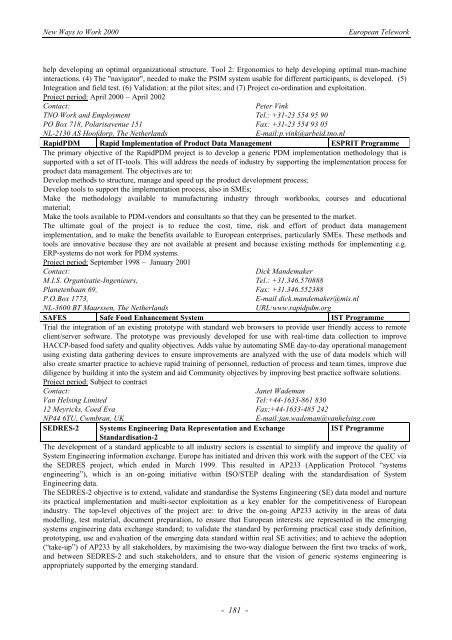eWORK 2000 - European Telework Week
eWORK 2000 - European Telework Week
eWORK 2000 - European Telework Week
- No tags were found...
You also want an ePaper? Increase the reach of your titles
YUMPU automatically turns print PDFs into web optimized ePapers that Google loves.
New Ways to Work <strong>2000</strong><strong>European</strong> <strong>Telework</strong>help developing an optimal organizational structure. Tool 2: Ergonomics to help developing optimal man-machineinteractions. (4) The "navigator", needed to make the PSIM system usable for different participants, is developed. (5)Integration and field test. (6) Validation: at the pilot sites; and (7) Project co-ordination and exploitation.Project period: April <strong>2000</strong> – April 2002Contact:TNO Work and EmploymentPO Box 718, Polarisavenue 151NL-2130 AS Hoofdorp, The NetherlandsPeter VinkTel.: +31-23 554 95 90Fax: +31-23 554 93 05E-mail:p.vink@arbeid.tno.nlRapidPDM Rapid Implementation of Product Data Management ESPRIT ProgrammeThe primary objective of the RapidPDM project is to develop a generic PDM implementation methodology that issupported with a set of IT-tools. This will address the needs of industry by supporting the implementation process forproduct data management. The objectives are to:Develop methods to structure, manage and speed up the product development process;Develop tools to support the implementation process, also in SMEs;Make the methodology available to manufacturing industry through workbooks, courses and educationalmaterial;Make the tools available to PDM-vendors and consultants so that they can be presented to the market.The ultimate goal of the project is to reduce the cost, time, risk and effort of product data managementimplementation, and to make the benefits available to <strong>European</strong> enterprises, particularly SMEs. These methods andtools are innovative because they are not available at present and because existing methods for implementing e.g.ERP-systems do not work for PDM systems.Project period: September 1998 – January 2001Contact:M.I.S. Organisatie-Ingenieurs,Planetenbaan 69,P.O.Box 1773,NL-3600 BT Maarssen, The NetherlandsDick MandemakerTel.: +31.346.570888Fax: +31.346.552388E-mail dick.mandemaker@mis.nlURL:www.rapidpdm.orgSAFES Safe Food Enhancement System IST ProgrammeTrial the integration of an existing prototype with standard web browsers to provide user friendly access to remoteclient/server software. The prototype was previously developed for use with real-time data collection to improveHACCP-based food safety and quality objectives. Adds value by automating SME day-to-day operational managementusing existing data gathering devices to ensure improvements are analyzed with the use of data models which willalso create smarter practice to achieve rapid training of personnel, reduction of process and team times, improve duediligence by building it into the system and aid Community objectives by improving best practice software solutions.Project period: Subject to contractContact:Van Helsing Limited12 Meyricks, Coed EvaNP44 6TU, Cwmbran, UKJanet WademanTel:+44-1633-861 830Fax:+44-1633-485 242E-mail:jan.wademan@vanhelsing.comIST ProgrammeSEDRES-2 Systems Engineering Data Representation and ExchangeStandardisation-2The development of a standard applicable to all industry sectors is essential to simplify and improve the quality ofSystem Engineering information exchange. Europe has initiated and driven this work with the support of the CEC viathe SEDRES project, which ended in March 1999. This resulted in AP233 (Application Protocol “systemsengineering”), which is an on-going initiative within ISO/STEP dealing with the standardisation of SystemEngineering data.The SEDRES-2 objective is to extend, validate and standardise the Systems Engineering (SE) data model and nurtureits practical implementation and multi-sector exploitation as a key enabler for the competitiveness of <strong>European</strong>industry. The top-level objectives of the project are: to drive the on-going AP233 activity in the areas of datamodelling, test material, document preparation, to ensure that <strong>European</strong> interests are represented in the emergingsystems engineering data exchange standard; to validate the standard by performing practical case study definition,prototyping, use and evaluation of the emerging data standard within real SE activities; and to achieve the adoption(“take-up”) of AP233 by all stakeholders, by maximising the two-way dialogue between the first two tracks of work,and between SEDRES-2 and such stakeholders, and to ensure that the vision of generic systems engineering isappropriately supported by the emerging standard.- 181 -








